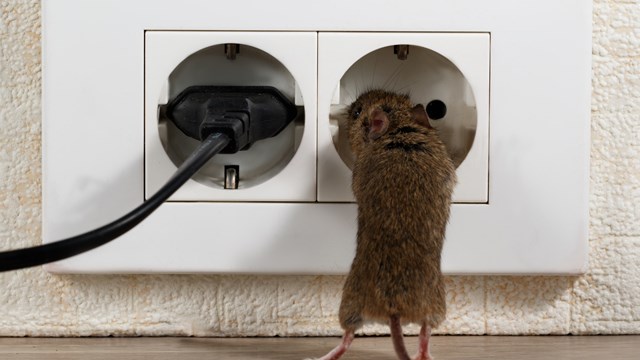Whether interior or exterior, well-built, properly-maintained woodwork can last for centuries but if wood-boring pests like beetles, termites, and carpenter ants find their way into the wood, they can wreak all kinds of havoc. Wood-destroying insects are more than a nuisance; they are dangerous and can cause significant, costly damage to the structure of a townhome, condo or co-op. They can also cost a small fortune to eradicate.
Wood You Rather
Even with its abundance of concrete and steel-beam construction, Chicagoland condos—particularly more suburban ones—can still fall prey to wood-chewing pests attacking elements like decks, door frames, and railings.
“Ants are the most common pests, both inside and outside,” says Vito Brancato, general manager of ABC Humane Wildlife, Control & Prevention in Arlington Heights. “They can be a year-round problem, and pick up in the summertime. Mostly they are just a nuisance, but carpenter ants can find areas of moisture and feed on wood that’s easy for them to consume.”
According to the University of Illinois Extension office, carpenter ants are drawn to indoor and outdoor areas with high moisture levels, such as bathrooms, basements, laundry areas, sweating or leaking pipes and crawl spaces. Outdoors, they can be found in the rotting wood of tree stumps and roots, and in moist areas under roof shingles, gutters, window sills, near chimneys, firewood, in untreated wood products or in the soil.
Jeff Dworkin, president of Ecology Exterminating Service Corp. in Brooklyn, New York has been helping remove wood insects from urban and suburban condos and co-ops for more than 40 years. He consistently deals with termites and beetles that sneak in through furniture and floors. Dworkin says these beetles come in through antique furniture from overseas (particularly South America and Africa), bed-frames, desks and nightstands.
Whether wood-destroying insects enter buildings on their own searching for food, or hitch a ride on a piece of lumber, oftentimes you don’t even see them until the damage is being done. “Wood-destroying insects will damage wood while feeding on it, or creating tunnels and nesting areas in it,” Dworkin says. “They are generally very secluded, spending most of their time inside the wood they are invading.” The telltale signs of wood pest infestation include tiny pinholes visible on wooden surfaces, or even little piles of sawdust collecting under a wooden frame, art object, or piece of furniture—the debris left over from the critters’ chewing and tunneling.
An Insect Primer
According to Michael Bentley, Ph.D, staff entomologist for the National Pest Management Association (NPMA), while ants may be more common in some regions, “Termites and wood-destroying beetles are the most economically important wood-destroying pests that infest homes (including co-ops and condos) in the U.S.” Of the two, it’s termites that are the most problematic and economically important—and the pests are found in every state in the union but Alaska.
“Wood-destroying beetles are more widely distributed than termites, occurring in every state,” Bentley says. “However, they come second to termites in terms of economic importance. Termites are classified into three groups: subterranean, drywood, and dampwood, based upon their nesting preferences. Subterranean termites are the most widespread and costly group. For termites, adults and immatures are responsible for feeding damage [to wooden structures], while the larvae of wood-destroying beetles cause the most damage to lumber.” Both insect groups can inflict damage to homes year round. But adults are usually most visible or active during the spring.
And according to Bentley, some species of subterranean termite and several important species of wood-destroying beetle aren’t homegrown hassles—they were unintentionally introduced into the United States as invasive species, hitchhiking from other countries on solid wood packing materials, such as freight pallets or in ships’ dunnage.
“Non-native termites and wood-destroying beetles have originated from both tropical and temperate habitats,” he says. “Many of the most costly non-native termite species, including the Formosan and the Asian subterranean termite, originated from various countries in Asia.”
And it appears the invaders have gotten friendly with each other. In 2015, a hybrid species of subterranean termite was discovered in Florida that resulted from cross-breeding between the Asian and Formosan subterranean termite species. So far, Bentley says the hybrid termite is isolated in small pockets in South Florida but if it were to proliferate and spread across larger or more developed areas, it could be hugely destructive.
Working With Buildings
For most of the U.S.—including the Chicagoland area—insect issues tend to be seasonal, increasing in severity as temperatures rise and rainfall increases. These favorable weather patterns typically occur around early/mid-spring and linger through early autumn. To address these fluctuations, most buildings and HOAs work on a monthly service agreement with their pest control contractor, and when the exterminator arrives at the property, they are given a list of what shareholders or unit owners have problems.
“We’ll start with that list, and then we’ll cover the public areas, such as the basement, laundry room and storage units,” Dworkin says. “If it’s a smaller building, say under 16 units, we will just knock on every door and inquire about any problems. A high-rise building with 100 or more units usually goes by the requested service list.”
The pest experts stress that it’s very important for every resident in the building to understand the importance of looking for signs of wood-damaging insects and not to let even a mild infestation go unchecked.
“If someone notices a problem, they need to act on it and not wait, because this could not only cause more damage to their home, but to the other residents and the building itself,” says one exterminator. “They should call whoever is in charge of that in the building so we get notified.”
When Dworkin and his team come into a condo building or association, their first step is to assess the situation and draw up a treatment program. He says normally the calls come when something is spotted, since it’s difficult to do a preventative program for termites.
He suggests that buildings call for an inspection—especially for units on the lower floors—and that boards and management alert their residents to keep an eye out for warning signs. If a section or piece of wood feels oddly soft or spongy and it breaks easily, that usually means termites.
And termites aren’t the only six-legged nasties to watch for. “They should also be looking for ants with wings, because the kings and queens fly, so if they see a swarm in early spring or late fall, they should take that as a red flag and call us,” Dworkin says. “Residents or the property manager can also take photos and send them to us so we can ID the pest that way. That’s something that has changed a great deal over the years.”
Top Tips
Bentley encourages boards, managers, and residents alike to take a few simple steps to eliminate conditions that are make a property attractive to wood-destroying insects. He says the best way to prevent problems with wood destroying insects is to make sure that any water-damaged wood in your building or unit is replaced promptly, and that any wood used in your home or in structures around your property is stained or painted, since raw, untreated wood is far more vulnerable to pest infiltration than its varnished, painted, or stained counterpart.
Here are the NPMA’s top tips to help prevent a termite infestation:
● Keep basements, attics and crawl spaces well ventilated and dry.
● Repair leaking faucets, water pipes and A/C units on the outside of the home or building.
● Repair fascia and soffits and rotted roof shingles promptly and properly.
● Replace weather stripping and repair loose mortar around basement foundations and windows.
● Direct water away from your home or building through properly functioning downspouts, gutters and splash blocks.
“Termites are highly attracted to moisture, so any possible moisture sources such as leaky pipes, improperly sealed windows/doors, and poor exterior drainage should be corrected immediately,” Bentley says. “Additionally, preventing any structural lumber from making contact with soil is another effective way to prevent termites from feasting on your home.”
It is more difficult to prevent wood-destroying beetles from infesting structural lumber. However, an effective strategy for deterring both termites and wood destroying beetles is keeping firewood or other cellulose (yard waste, branches, tree stumps) off of the ground and stored away from the building.
Safer Products
Unlike decades ago, the modern options available to pest professionals for managing wood-damaging insects troubling your co-op or condo are registered with the Environmental Protection Agency (EPA), meaning they have been tested and are considered safe for people, pets, and the environment.
Today, the eradication of any indoor and outdoor pests is called integrated pest management, or IPM. “IPM is where we don’t just spray the heck out of everything,” says Steven Bessette, president, chief technology officer and founder of EcoSMART, an eco-friendly pest control company in Atlanta, GA. The company is a world leader in offering safe pesticide solutions. “With IPM, you find where the pests are coming from, locate the cause of the problem and treat with the least toxic available tools. And that comes back to botanicals, which meets the government’s highest safety standards.”
For example, Bessette continues, “If humans consume rosemary oil, it’s fine, but in an insect’s body, it binds to the receptors in the system and shuts it down. There’s no effect on people, pets or environment. That was the magic piece of the puzzle.”
When it comes to termites, the pros say new control options that have come about in the last 15-20 years include termite baiting, a treatment that exploits the bugs’ constant foraging behavior to transport the active ingredient back to the nest where they share the poisoned bait with their fellow nest-mates, thus eradicating the colony. Another option is a borate treatment that is most commonly applied to raw lumber before it’s even incorporated into a construction project.
Dworkin’s staff also uses a boric acid product called Boracare, which is injected directly into the ground via holes drilled through the cement near an affected building’s foundation. He also uses termite bait stations, the active ingredient in which inhibits the termites’ ability to molt, stunting their growth and ultimately wiping out the colony.
When it comes to other pests, like wood-boring beetles, for example—Dworkin says that his company’s eradication methods don’t affect tenants, their pets, or anything in the environment. When treating an infested piece of wooden furniture, “We use a hypodermic needle and inject each hole with a product that seeps in and kills the insect inside—it’s a slow process,” he says. “Then we take a light powder and spread it over the holes, and then cover it up for a week.” And after a week of quarantine, the furniture is beetle-free and can return to use.
These days, “All products are environmentally friendly, and there’s no odor, which is something that used to be a problem,” Dworkin says, and echoes Bessette’s targeted approach. “We also restrict treatment to where the termites actually are, as opposed to treating the whole building, which reduces the impact to the environment.”
Regardless of whether they’re just a nuisance (like kitchen ants) or a potentially costly threat (like termites), nobody wants bugs in their building. And while a certain amount of pest-related trouble is inevitable in any environment, by staying vigilant for the signs of trouble and removing as many risk-factors as possible from your property, you may be able to avoid having your woodwork chewed into sawdust by these strong-jawed invaders.
Keith Loria is a freelance writer and reporter and a frequent contributor to The Chicagoland Cooperator.







Leave a Comment